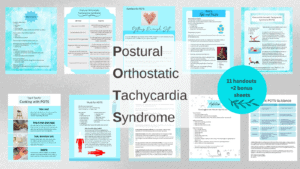Resources for Dietitians on POTS
- Handouts
- Resources
- FAQ
As the number of people with dysautonomia and Postural Orthostatic Tachycardia Syndrome (POTS) is increasing due to COVID, are you prepared to help them? It’s over 1% of the population and 30-80% of people with long COVID. That’s a tremendous amount of people who need support! Diet and lifestyle treatments are the first line of treatment and RDNs are often the practitioners seeing clients with POTS and we’re in a great position see what’s going on and guide patients.
Here are handouts with everything you need to help your clients get oriented to their new diagnosis, the diet and lifestyle changes and be able to anticipate and answer the questions you’ll get from every new POTS patient.
Patients want to know what POTS is, what’s going on in their body and what to expect.
- Understanding the physiology behind the electrolytes, fluid, compression, movement, etc. Patients are more likely to follow suggestions when they understand the why and how it will help them feel better.
- What kinds of diets might be helpful?
- When does exercise help? What kinds?
- What strategies and adaptive equipment can help make cooking easier?
- …and resources for the RDN to earn more about the types of POTS, testing, places to learn more.
This contains details on type of foods, meal size and spacing, exercise suggestions for POTS with specific guidance based on whether the client has long COVID POTS, Ehlers-Danlos, myalgic encephalomyelitis, etc., amount of salt and other electrolytes with practical suggestions, brands of electrolytes including ones to avoid, brands of compression garments and cooling tools and more.
- POTS and Diet
- POTS Basics and Exercise (2 page)
- Fluids for POTS
- Electrolytes
- Salt needed for POTS
- POTS Tips and Tricks
- Tips for Cooking with POTS
- POTS Myths and Facts
- POTS guidelines for adults, both for POTS and Long COVID POTS
- Simple Hydration Tips–you may find yourself using these suggestions and tools for a range of patients!
- Background info for RDNs (not intended for patients)
11 handouts, NON BRANDED, with space to add your practice tagline
Added bonus— an extra 2 pages of references and resources for RDNs to learn more about POTS with FAQ
Resources for testing
- NASA lean test
- https://www.dysautonomiainternational.com/
- And of course, if your patient feels better lying down than standing up, that’s a big red flag that dysautonomia might be part of the patient’s clinical picture.
Want to learn more? Here are some good resources
- COVID-19 Increases the Prevalence of Postural Orthostatic Tachycardia Syndrome: What Nutrition and Dietetics Practitioners Need to Know
https://www.sciencedirect.com/science/article/pii/S2212267222003422 - POTS Podcast from Soundbites for CEUs for RDNs:
https://soundbitesrd.com/podcast-episode-223-pots-postural-orthostatic-tachycardia-syndrome-cheryl-harris
(more info and articles in the show notes) - Dysautonomia International
www.dysautonomiainternational.org/ - Salty food ideas: http://www.dysautonomiainternational.org/page.php?ID=145
- Info on Dysautonomia and long COVID:
https://dysautonomiainternational.org/pdf - LongCOVID_Dysautonomia_PressRelease.pdf
Podcast with every episode about POTS:
https://www.standinguptopots.org/podcast - Did you get a patient prescription in grams of sodium and need to convert to salt? Here’s a good resource: https://www.heartfoundation.org.au/sodium-and-salt-converter
Ideally, new patients with POTS are screened for eating disorders before diet change is considered. - Rates of overlap between Long COVID/POTS vary significantly. The 80% figure comes from this June 2023 study: https://www.amjmed.com/article/S0002-9343(23)00402-3/fulltext
FAQ
What are the primary kinds of POTS
Hypovolemic POTS, or low blood volume related—most people with POTS have lower blood volume, on average, about a 1/3 of a liter, or 1.5 cups. For context, this is a little less than the amount taken when someone gives blood…but it’s all the time, and of course, it’s variable.
Hyperadrenergic POTS, or having elevated levels of norepinephrine, otherwise known as adrenaline, and general sympathetic system activation This can contribute to the sense of anxiety, even when patients know that they aren’t nervous about anything. Fluid and electrolytes have been shown to lower norepinephrine levels. https://pmc.ncbi.nlm.nih.gov/articles/PMC8103825/
Neuropathic POTS:
This is characterized small fiber neuropathy, and by blood pooling. The persons’ extremeties may turn blue, red, purple or almost black. Compression garments may be particularly helpful.
Can my patients have all types? What if my patient doesn’t know their type?
Many patients have features of all, and many doctors don’t specifically diagnose a type, so it’s not important if your patient doesn’t know.

